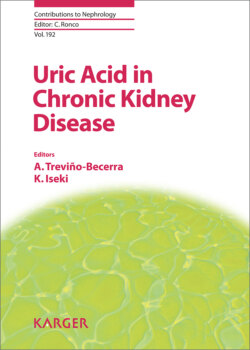Читать книгу Uric Acid in Chronic Kidney Disease - Группа авторов - Страница 26
На сайте Литреса книга снята с продажи.
Hyperuricemia and Metabolic Syndrome
ОглавлениеIt is well accepted that individuals who are hyperuricemic and hyperlipidemic, particularly those with abdominal obesity, may be a high-risk group for cardiovascular events: reviewed evidence supports inclusion of hyperuricemia resulting from impaired renal uric acid clearance as an intrinsic component of the metabolic syndrome of hyperinsulinemia and resistance to insulin action.
Several epidemiological investigations have confirmed the association of hyperuricemia with metabolic syndrome. Some have suggested that uric acid may simply be a consequence of the increased uric acid absorption in the proximal tubule secondary to hyperinsulinemia, and others believe that uric acid may predict the development of metabolic syndrome, obesity, and diabetes [25].
A fructose-rich diet can raise uric acid production and induce the components of metabolic syndrome through mechanisms independent of energy intake or weight gain. These effects are not observed with a glucose-rich diet. Recently, uric acid also was found to have a causal role in the metabolic syndrome that was induced experimentally by fructose. Fructose rapidly raises uric acid as a consequence of activation of fructokinase with ATP consumption, intracellular phosphate depletion, and stimulation of AMP deaminase. Lowering uric acid in fructose-fed rats ameliorates much of the metabolic syndrome, including a reduction in blood pressure, serum triglycerides, hyperinsulinemia, and weight gain. The rise in uric acid after fructose ingestion likely has a significant role in inducing insulin resistance via its effect to lower nitric oxide and also possibly by a direct effect of uric acid on the adipocytes [26].
Data also support an association between hyperuricemia and endothelial dysfunction in human and importantly, support the fact that this endothelial dysfunction can be reversed by the administration of allopurinol in animal model as well as in human subjects. Since oxidative stress in adipocytes has been considered a major factor of insulin resistance, hyperuricemia-induced oxidative stress in adipose tissue might play a key role in these dysregulations [27].
